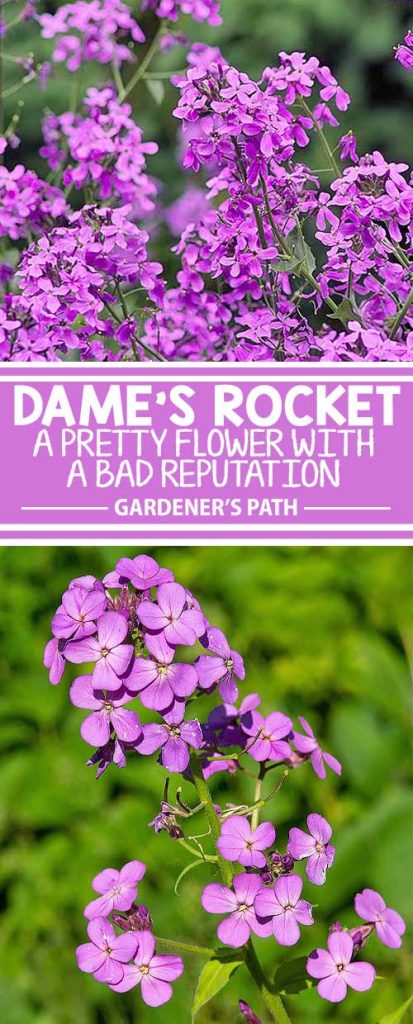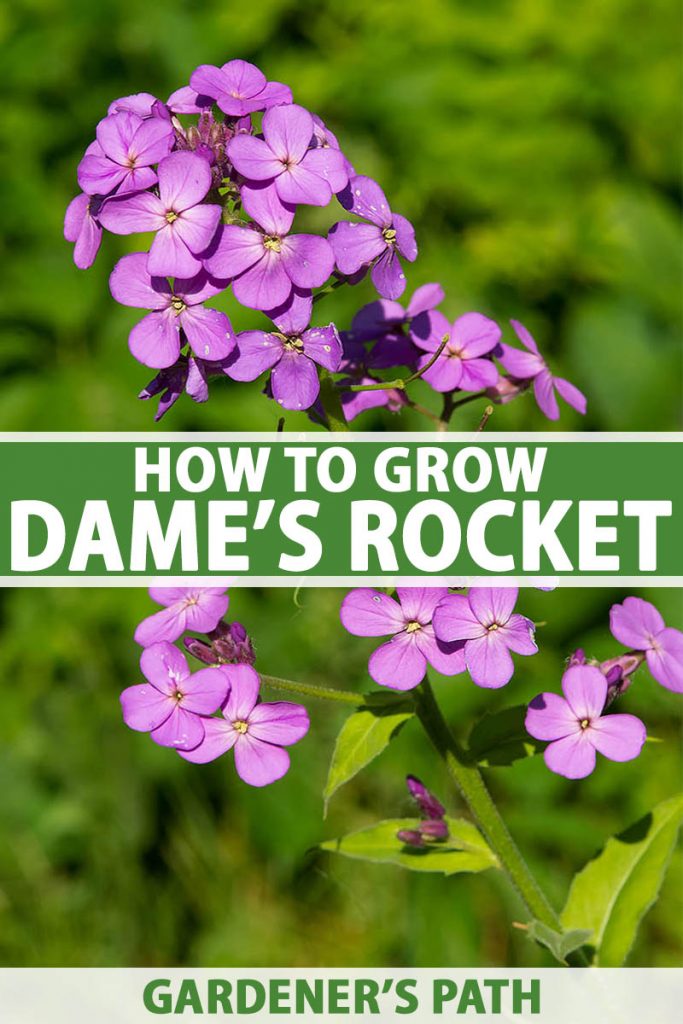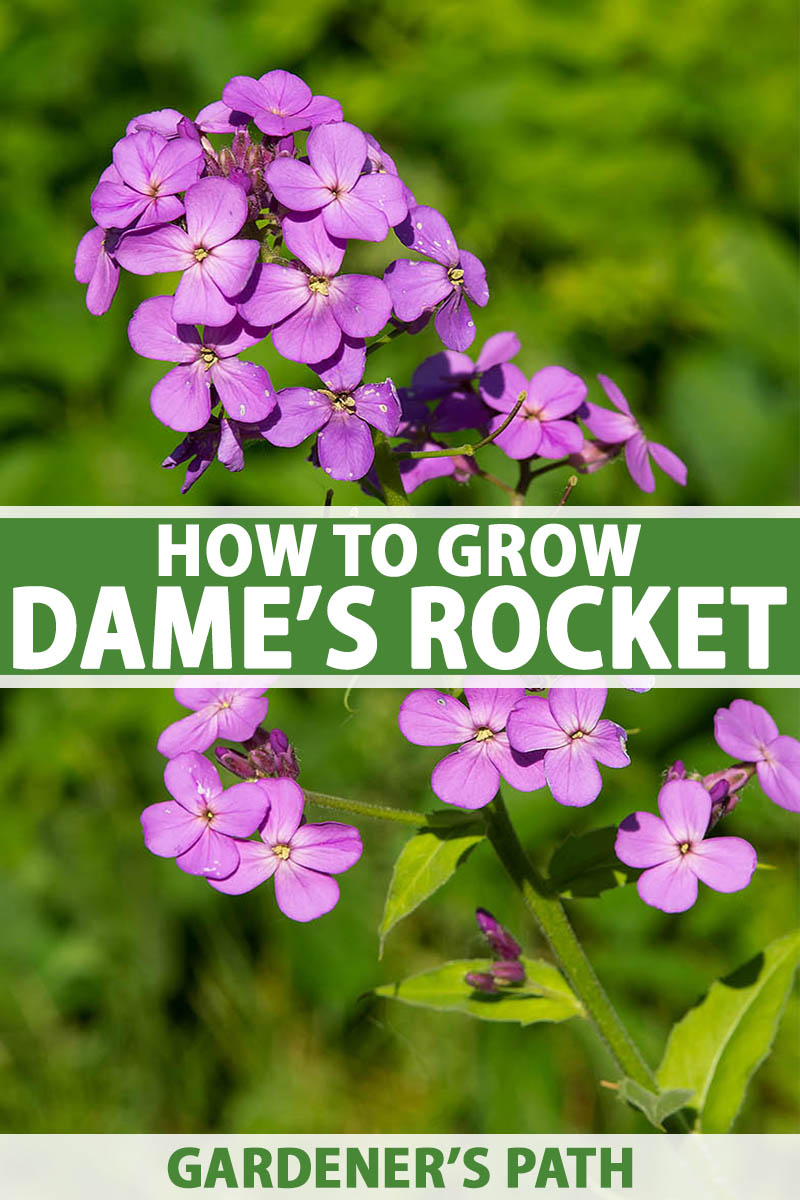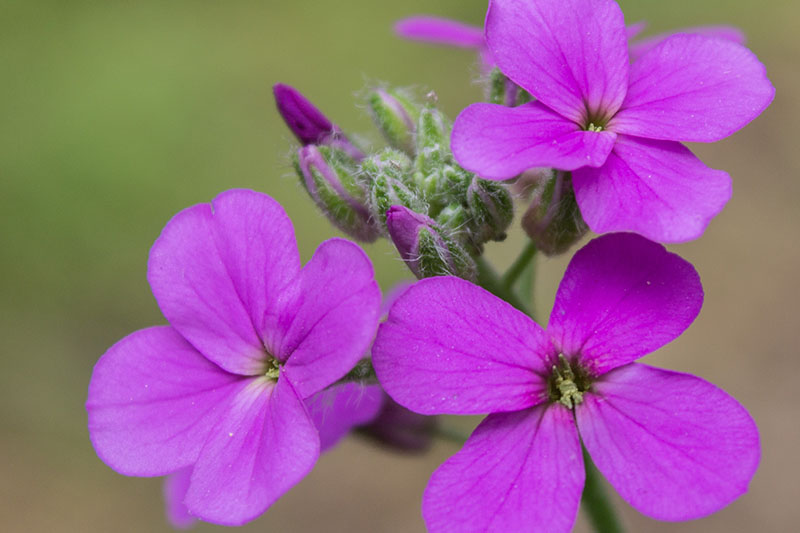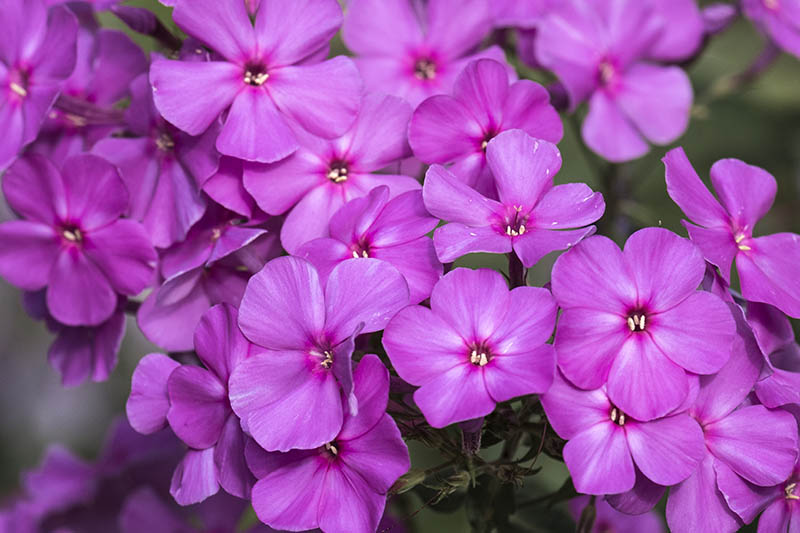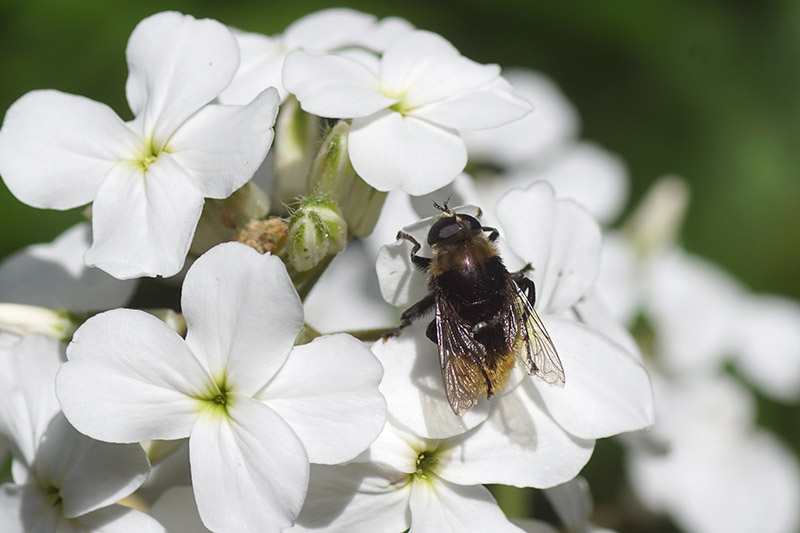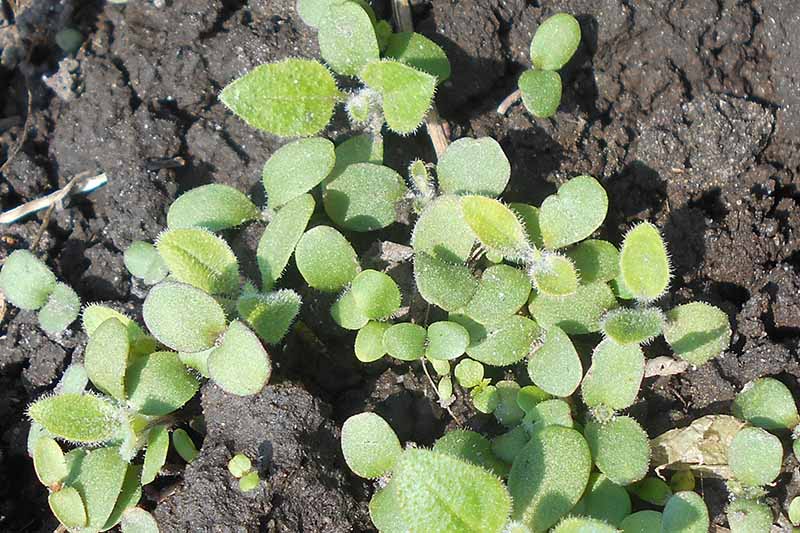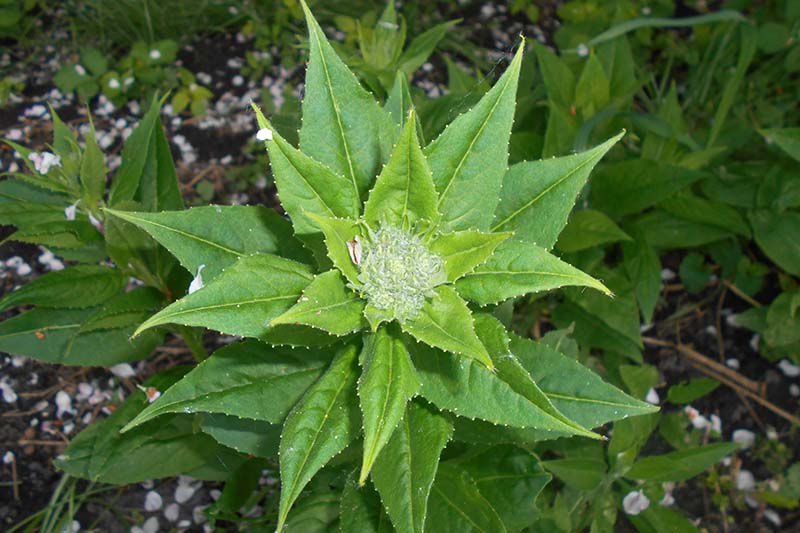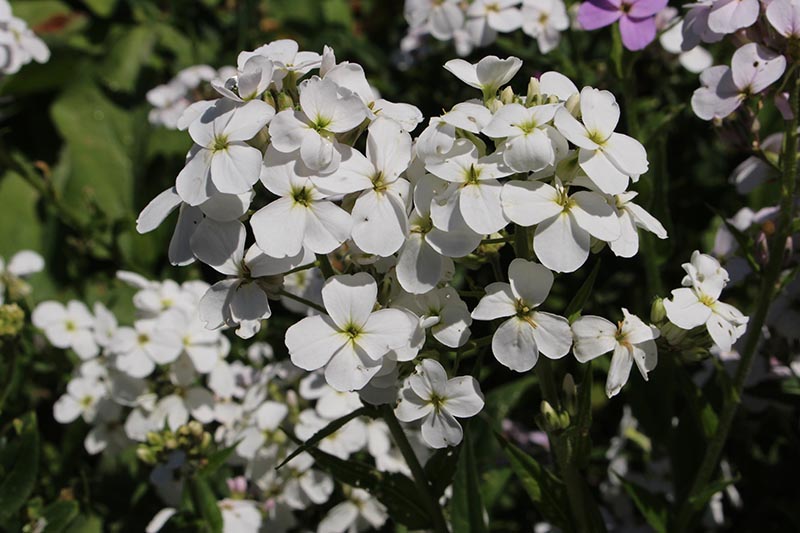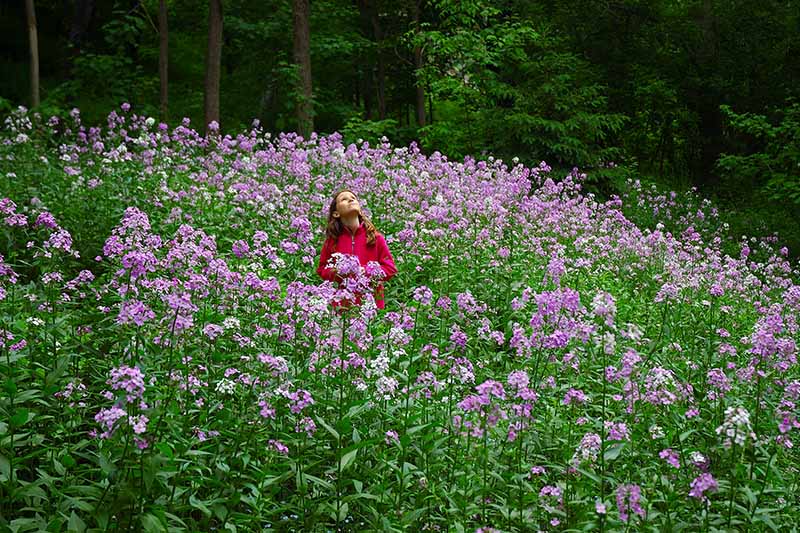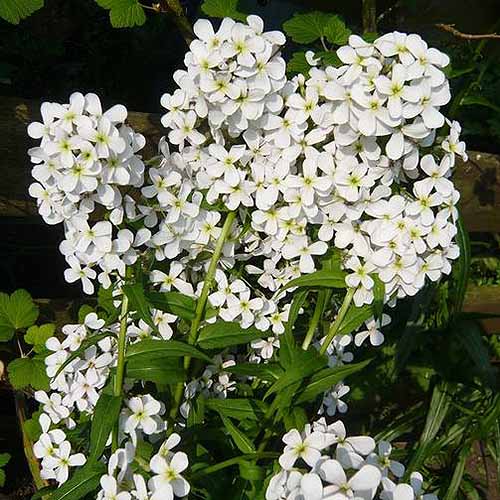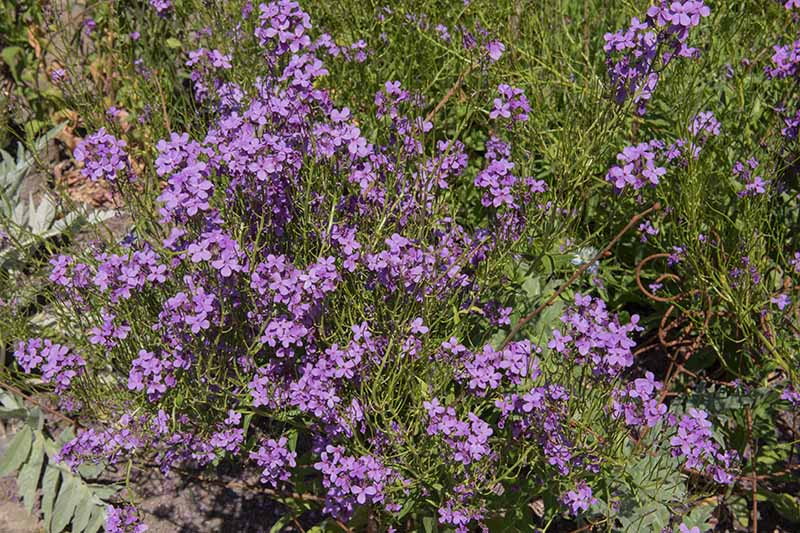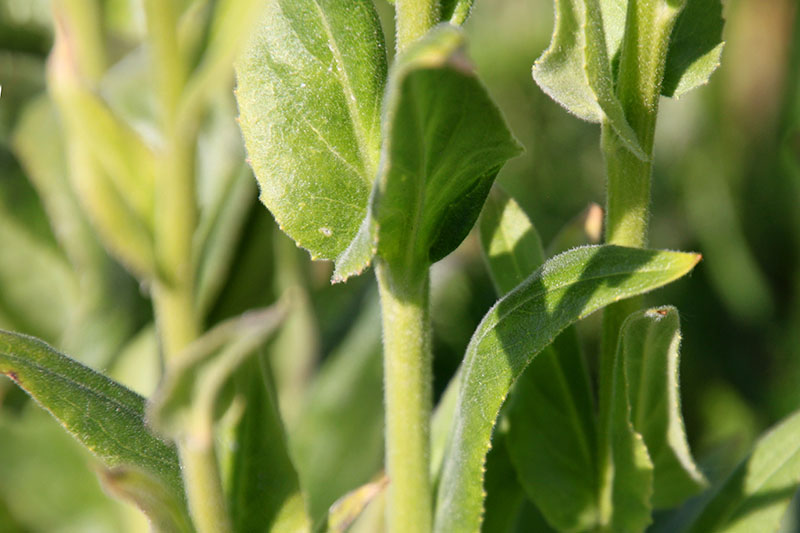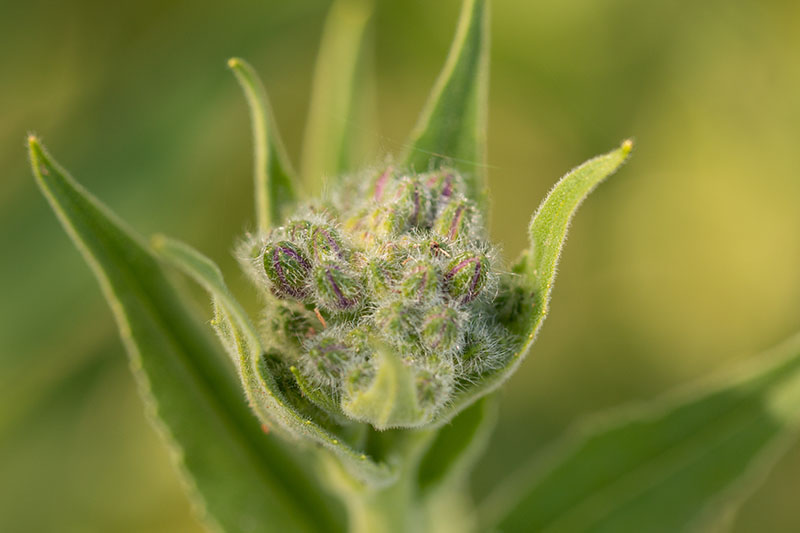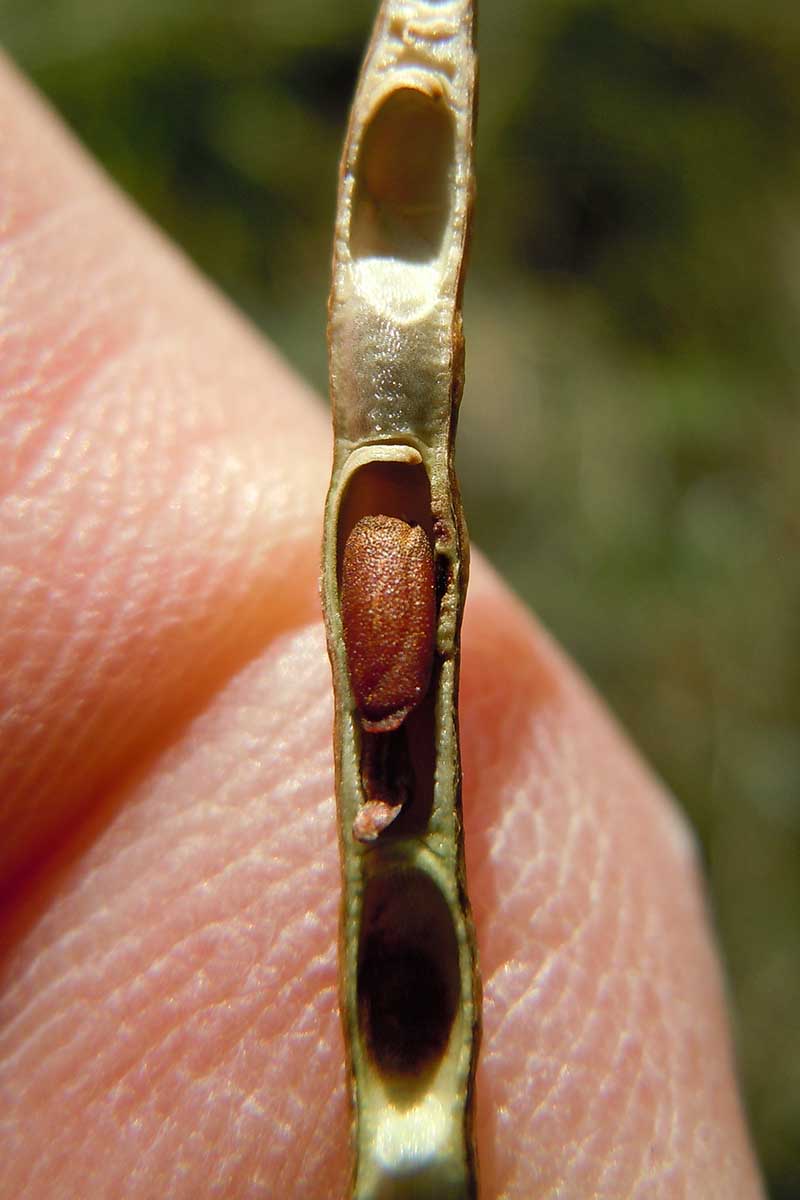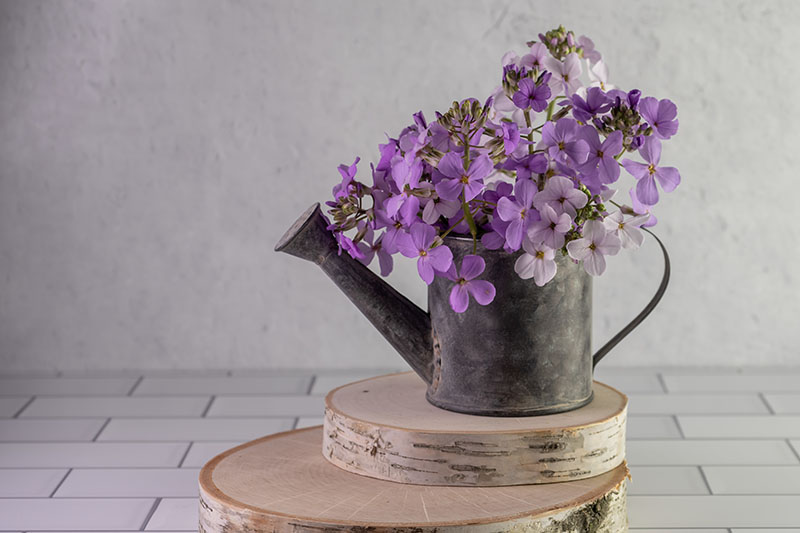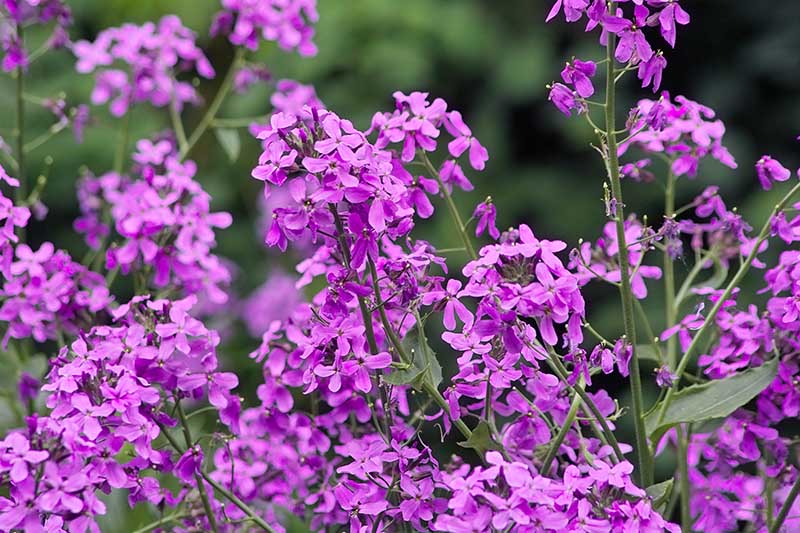Native to Europe and Asia, it was originally brought to the United States as an ornamental plant. As with many introduced varieties, its seed spread beyond garden borders and naturalized in surrounding woodlands and meadows. Unfortunately, it is an aggressive grower that competes with native plants, threatening natural ecosystems with its spread. We link to vendors to help you find relevant products. If you buy from one of our links, we may earn a commission. Cultivation is against the law in some states, including Colorado, Connecticut, Massachusetts, New Hampshire, and Wisconsin. If you are gardening in the US, please consult your local agricultural extension before planting, or you might find you’re breaking the law. Many plants can become invasive under ideal growing conditions. Be aware that if you allow seeds to disperse from this plant, it will spread readily under ideal growing conditions. In this article, you will learn how to grow dame’s rocket, a wildflower that knows no bounds. Why? Because you may want to grow it for its pretty flowers and edible leaves. Or, you may need to identify and eradicate it without mixing it up with other flowers that look similar. And interestingly, this outlaw wildflower is enjoyed by domestic goats, so if you’ve got a herd to feed, or even one hungry horned buddy, you’re definitely going to want to read on. Here’s what I’ll cover:
What Is Dame’s Rocket?
You may know H. matronalis as mother-of-the-evening, damask violet, dame’s violet, or gillyflower, a generic common name used for several fragrant flowers.
It looks like a native garden phlox, Phlox paniculata, but to be certain, count the petals. H. matronalis has four, but phlox varieties have five. In addition, dame’s rocket has leaves that alternate along the stem while phlox leaves are arranged opposite each other. This plant also bears some resemblance to native fireweed, Chamaenerion angustifolium. And while fireweed also has four petals, they are narrower, and each blossom has eight distinguishing long white stamens that protrude from the center. The seed pods of H. matronalis are especially long and narrow, another identifying feature. For definitive identification, collect seeds for evaluation by your local agricultural extension. Dame’s rocket is a biennial, which means it blooms in the second year of growth. After pollination and seed formation, it is a vigorous self-sower. If it’s allowed to drop seed, you’ll soon enjoy a continuous yearly bloom, as you would with a perennial plant.
Another unique characteristic of this plant is that it bears blossoms and seed pods simultaneously. The leaves, sprouted seeds, and dried seeds of dame’s rocket are edible. They have been used for medicinal purposes and are purported to be endowed with aphrodisiac properties. Its names are interesting as well. The Latin word hesperis refers to evening, the time when the flowers emit a fragrance that’s a cross between that of cloves and violets. And matronalis comes from the Roman festival, Matronalia, a celebration of Juno, the goddess of motherhood and childbirth. As for its common name, “dame” is no surprise, given its feminine origins. But, where does the rocket come from? Perhaps from its edible leaves. In Europe, its cousin arugula is called “rocket.” It is believed that this plant was introduced to North America in the 1600s, so it’s had plenty of time to make itself at home. In the first year, plants produce leaves. They are lance-shaped with serrated margins, and form a mound at the base of the plant in a rosette shape called a basal whorl. In the second year, hairy stems grow. They have alternating hairy leaves and end in racemes – or clusters of showy blossoms. Each has four claw-shaped petals that are wide at the top and narrow at the base. The flowers may be magenta, pink, purple, or white. In addition to botanical species, which has one row of petals, there are cultivars with two.
Bloom times range from May to August. H. matronalis is a fairly tall plant with stems that range from one to three feet, or sometimes four feet in height. It has an upright, mounding growth habit with sparse branching. Mature widths are between one and two feet. Plants grow in full sun to part shade with average soil, provided it drains well, and the roots are shallow. It’s no wonder it spreads easily along the edges of gravelly roadways. Dame’s rocket seeds are sometimes included in wildflower mixes, so beware.
Propagation
Botanical species H. matronalis, as found in nature, grows from seed. However, to reproduce a hybrid cultivar, it’s necessary to take a stem cutting or division from a parent plant to create a clone, as hybrids do not reproduce true from seed.
From Seed
Direct sow seed outdoors any time after the average last spring frost date and up to eight weeks before the average first frost date in the fall. Scatter seeds on top of moist soil. They require light to germinate, so do not cover them.
From Stem Cuttings
You may take soft tip cuttings from new spring growth, but some gardeners say this is a challenging way to start a plant that grows so well from seed. If you are growing a hybrid variety that will not produce true to seed, then you can try to root a stem cutting. Take a four to six-inch cutting from the stem, and dip the cut end into powdered rooting hormone before placing it in soil. Or place the cuttings in a glass of water until you see roots, then transplant.
By Division
While dividing plants is possible, it’s not sensible. Yes, you can cut down through its roots in early spring, dig up the cut portion, and plant it elsewhere, per the instructions in our guide to dividing perennials. However, this is a biennial plant, so it’s only going to live for two years, and while this method enables the replication of a hybrid, it’s just not worth the trouble.
How to Grow
Find a full sun to part shade location. The soil should be of average quality with good drainage and a pH of 6.0 to 7.5. Work the soil in your garden to a depth of 10 to 12 inches, working in a little sand or organic matter such as compost to improve drainage as needed. Moisten the soil and gently press two or three seeds onto the surface at intervals of 12 to 24 inches. Maintain even moisture during germination, but do not oversaturate the soil. Once the seeds sprout and have at least one set of true leaves, thin them so there is one plant growing every 12 to 24 inches. Provide an inch of water per week in the absence of rain. If you’ve started seeds indoors, plant them out when all danger of frost has passed and seedlings have one or two sets of true leaves. To do this, prepare the soil as described above, and dig a hole the same depth and width as the root ball. Gently remove the seedling from its container and place in the hole, and backfill with soil. Water in well. For container gardening, choose a pot with good drainage, a rim diameter of between 12 and 24 inches, and a depth of 12 inches. Fill it with a good quality potting medium that has good moisture retention, and transplant as described.
Growing Tips
Sow seeds any time after the last spring frost date, and until eight weeks prior to the first average fall frost date. Press seeds on top of moist soil as they need light to germinate. To replicate hybrid plants, don’t rely on seeds.
Pruning and Maintenance
This is a dynamic plant that thrives with little intervention. If you are trying to contain its spread, you’ll want to minimize seed drop.
You can do this by cutting faded stems down to the base. However, when to do this is a tough judgment call with a plant that has budding flowers at the top of the cluster, and fading ones setting seed at the bottom. You’ll have to sacrifice some top blooms to do this, but you may be rewarded with a second flush of blooms later in the season, as well as fewer seeds dropped.
An inch of water per week is adequate. In the event of a dry spell, you may want to provide supplemental water. Be more vigilant with container-grown plants, as pots dry out quicker than ground soil. Weed regularly to inhibit competition for water from other vigorous invasives, such as garlic mustard, Alliaria petiolata (which is also edible, by the way, and I hear it makes a tasty pesto…). Apply a two-inch layer of mulch to aid in water retention and inhibit weed growth. Especially tall plants may benefit from staking.
Cultivars to Select
Despite the invasive tendencies of H. matronalis, seeds are readily available. However, some purveyors will not ship to states where its growth is prohibited. Deer don’t bother with it. That figures!
Mixed Colors
H. matronalis ‘Mixed Colors’ offers a varied palette of pinks, whites, and purples.
H. matronalis ‘Mixed Colors’ Suited to sun and partial shade, plants grow to 30 inches tall. Find seeds now from Eden Brothers in 1-ounce, 1/4-pound, 1-pound, and 5-pound packages.
Violet
H. matronalis ‘Violet’ exudes old-fashioned charm with its clusters of rich violet blooms.
H. matronalis ‘Violet’ Suited to both sun and partial shade, this type reaches heights of 30 inches. Find seeds now from Eden Brothers in packages of 1 ounce, 1/4 pound, and 1 pound.
White
H. matronalis ‘White’ grows to a height of approximately 30 inches.
H. matronalis ‘White’ Flowers exude cottage garden charm with their crisp white petals, in both sun and partial shade. Find seeds now from Eden Brothers 1-ounce, 1/4-pound, and 1-pound packages.
Managing Pests and Disease
As you might expect, this is not a plant that is prone to problems with pests or disease.
However, it is occasionally preyed upon by flea beetles that feed on foliage and leave them riddled with holes. A pyrethrin treatment may be required. In wet weather, slugs and snails may feed on plant tissue. You can trap them or pick them off if they are problem. And a rainy, humid summer may promote the growth of a fungal disease called powdery mildew. This causes the foliage to look at though it has been dusted with flour. It may be necessary to remove affected foliage and/or treat with a fungicide.
Harvesting, Cooking, and Preservation
Enjoy sprouted seeds or pick tender young microgreens for use in salads and sandwiches. The pungent, somewhat bitter foliage is rich in vitamin C.
Try substituting H. matronalis for the arugula in this fresh green salad with beets and goat cheese from our sister site, Foodal. Lightly saute young leaves and buds for a tangy wilted greens side dish.
And be sure to snip blossoms for attractive garnishes on cold entrees, sides, and desserts. Collect the seeds after the flowers have withered to save to plant next year, or press them for oil. The oil extraction process is beyond the scope of this article, but feel free to let us know if you give it a try. Save seeds in an airtight jar for up to one year in a cool, dry location.
Best Uses
The shallow roots make dame’s rocket a good candidate for container gardening. Keep it on a patio to curb its spread and have it handy for picking.
H. matronalis looks great in cottage garden settings and wildflower gardens, but never forget that it’s a strong competitor for nutrients and water. However, its invasive nature must not be ignored. Especially in areas where it’s prohibited. Like the bachelor’s button cornflower, it has become a country classic, bordering highways and dotting meadows across our nation. However, it also threatens the habitat of local bees, birds, and butterflies.
Mindful of this information, if you choose to cultivate H. matronalis, you may want to contain it as the European ornamental it once was. Remove the seed pods for home use or reseeding next spring, rather than letting them scatter into the environment. Our article on gardening in small spaces has some great container ideas to help you keep this plant in check. What are your thoughts about dame’s rocket? Do you grow it? Serve it in salad? Feed to your goats? Let us know in the comments section below. If you’re looking for native wildflowers to populate your flower garden, here are some articles to read next:
15 of the Best Native Wildflowers for the US and Canada How to Grow Blackfoot Daisy 11 Native Blue Wildflowers for the Garden Grow New England Aster for Sensational Summer and Fall Color
© Ask the Experts, LLC. ALL RIGHTS RESERVED. See our TOS for more details. Originally published: August 6, 2017. Last updated: August 2, 2020. Product photos via Eden Brothers. Uncredited photos: Shutterstock. The staff at Gardener’s Path are not medical professionals and this article should not be construed as medical advice intended to assess, diagnose, prescribe, or promise cure. Gardener’s Path and Ask the Experts, LLC assume no liability for the use or misuse of the material presented above. Always consult with a medical professional before changing your diet or using plant-based remedies or supplements for health and wellness.
